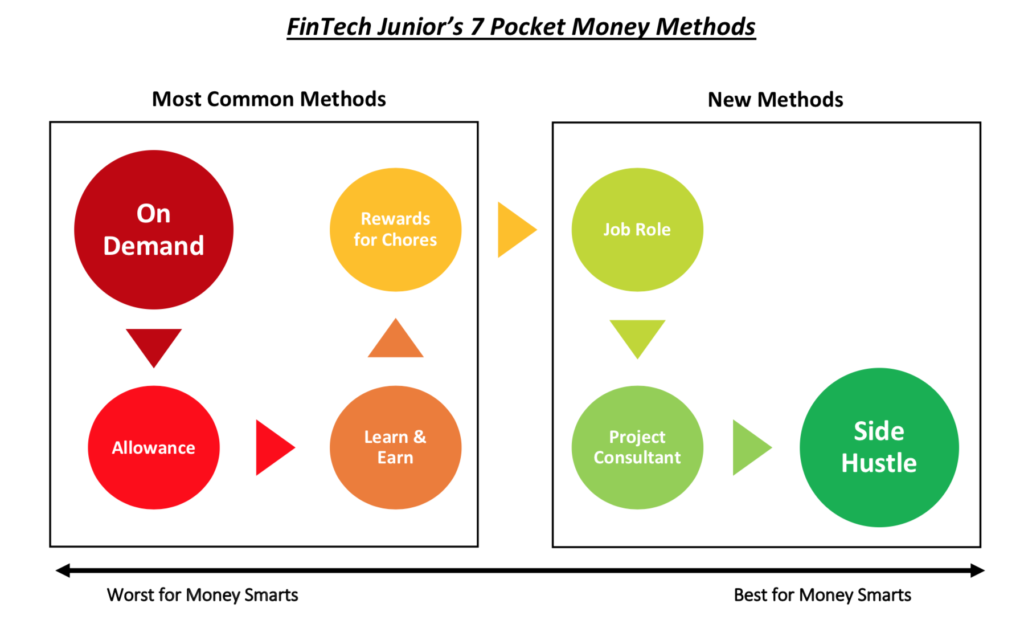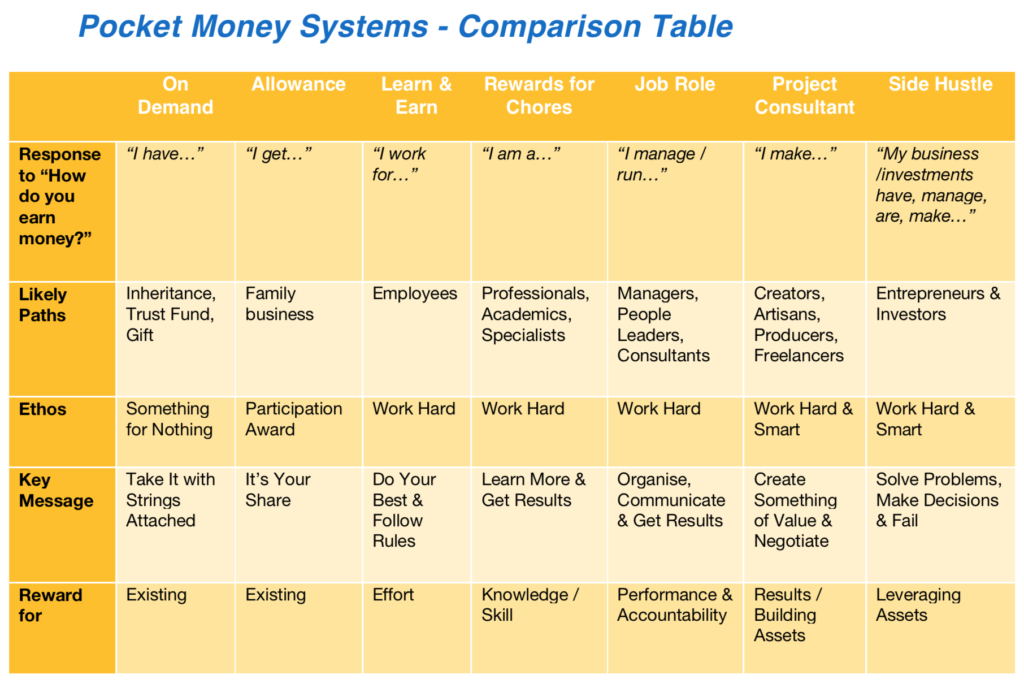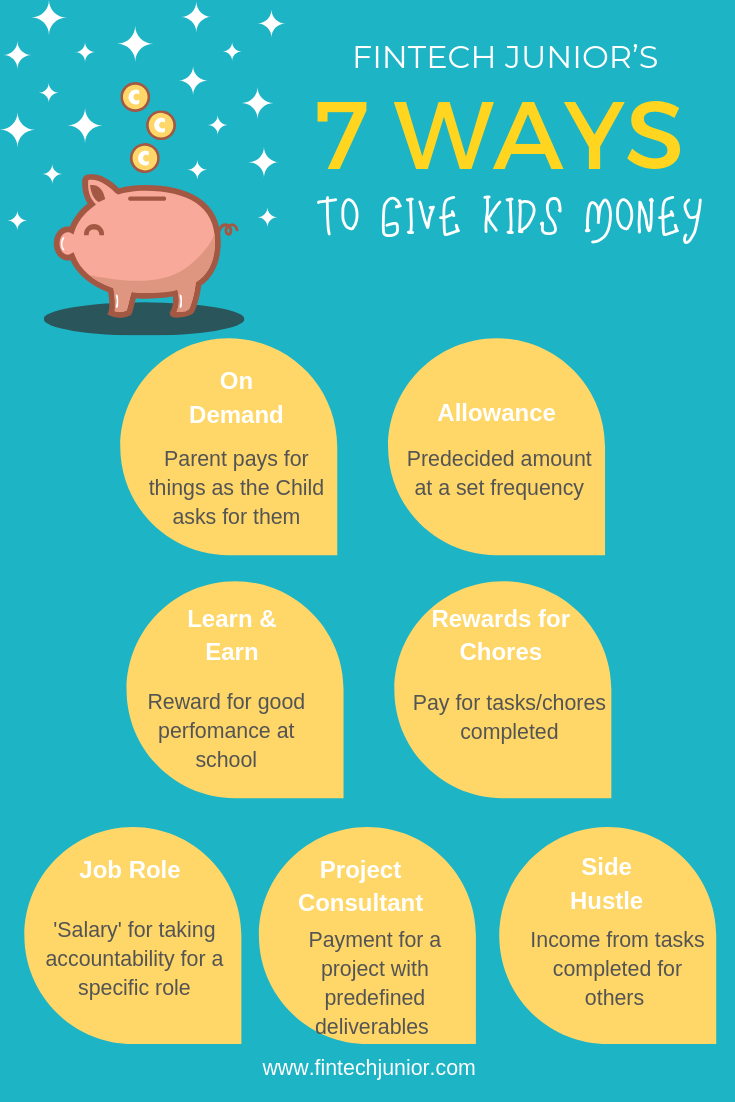The 4 Most Common Pocket Money ‘Systems’ Out There + 3 New Ones
Whether you call it pocket money, allowance or commission, we can all agree that we need to have some way to give our kids money. So, what is a Pocket money system you ask?
Well my friend, it’s no longer good enough to give your kids a list of chores and hand over some moolah on a semi- regular basis. If you are going to do this right and get your child future ready, you need a proper system.
Now it’s not as intimidating as it sounds. All it means is that you have to spend a little time upfront understanding why you are giving out pocket money in the first place and what you want to achieve.
One important thing to keep in mind is that each of these methods relates to the ’earning’ part of the money equation. None of them dictate the ‘using’ part of the equation, i.e. the spending, saving, giving, growing and managing. This is usually upto each family to define and that’s the main reason why most pocket money attempts fail.
So, with that in mind, let’s look at each of these methods one by one and understand their pros and cons.
P.S: I prefer calling it a program or method. System makes it sound so complex!

1. THE ‘ON DEMAND’ METHOD
No money is given to the child. The parent spends ad hoc whenever the child needs or wants something. Parents simply pay on demand for the things they are willing to let their kids have. That’s the catch, right there. The child has to ask permission to spend money for a specific purchase, every time. What this means is that all spending is at the discretion of the parent and parents can allow or deny their kids from having stuff.
Parental rationale
“What does my child need money for, they get everything they need.”
How to implement this pocket money method
1. Whenever your child wants something, they ask if they can have it.
2. As the parent, you decide yes or no and if yes, how much money they can spend on it.
3. You give your child that much money or you buy the item for them.
Payment Amount
Variable – parent controls
Payment Frequency
Ad hoc – child controls
Pros:
- Very easy to implement. Parents simply pay up when asked.
- Consistent as no work required by the child
- Parents control what kids buy
- Parents control how much kids spend
Cons:
- Parents control how much kids get
- Child has no discretion on use
- Parent manages money on Childs behalf
- No ability to learn how to earn
- Limited opportunity to make mistakes = limited opportunity for learning
2. THE ‘ALLOWANCE’ METHOD
Paid as an entitlement or as a share of the family money to the children. This is usually a pre-decided amount that is given to the child on a set frequency. The child doesn’t have to do anything to ‘earn’ it. However, some parents give it out for ‘responsible’ children and consequently, it can be taken away for inappropriate behaviour. Spending the money is usually up to the child, so there are still money management lessons that can be taught using this method.
Parental rationale
“I don’t want my child to think they should get paid for helping around the house.”
How to implement this pocket money method
- Wait for your child to do something particularly responsible.
- Sit them down and explain that now that they are a ‘big boy/girl’ they are going to get added responsibility of sharing in the family’s money.
- Agree an amount and frequency of payment.
- Explain that this is a privilege and what your expectations are.
Payment Amount
Fixed – parent controls
Payment Frequency
Fixed – parent controls
Pros:
- Easy to implement as its not contingent on anything except parents having the right change.
- Consistent as no work required by the child
- Child has discretion on use
- Opportunity to learn money management skills
Cons:
- Parents control how much kids get
- No ability to learn how to earn
- Parents may use Allowance as a punishment
- Develops a sense of entitlement
3. THE ‘LEARN & EARN’ METHOD
Money is given as a reward for good performance in academics or athletics. Usually this style of pocket money is tied to a child’s efforts in being good at school.
Parental rationale
“I want my child to focus on school and not get distracted.”
How to implement this pocket money method
- Decide if your monetary reward will be tied to 1 or more categories of learning – Academics, Athletics or Extra Curricular.
- Then decide if you want to encourage performance in certain specific subjects or overall? Will you deduct money for poor performance?
- Will your child be rewarded for efforts or only achievement?If you choose to reward for effort, how will this be measured – based on homework or additional study time or some other way?
- Once you have defined the above parameters, decide on the pay grades – what mark gets what amount.
- Communicate this to your child and you’re off to the races.
Payment Amount
Variable – child controls
Payment Frequency
Fixed – parent controls
Pros:
- Relatively easy to implement
- Consistent as no extra work is required from the child apart from school
- Kids control how much they earn
- Child has discretion on use
- Opportunity to learn money management skills
Cons:
- Payment for no additional effort
- Potential to overpay, if performance goals are met
- Sends the wrong money messages to child
What money message does it give your child?
Be a good little rule follower. Only results matter, not effort and failure must be avoided at all costs. It also puts additional pressure and stress on your child to perform on standardised tests.
4. THE ‘REWARD FOR CHORES’ METHOD
Do a long list of chores, get paid. This is closes to a daily wage system where ‘workers’ are paid for tasks completed. Do a task, get paid. Don’t do a task, don’t get paid. Number of chores and payment amounts per chore can vary based on time and effort.
Variations
Some variations of this method say do three chores a week, some list 35 chores a week. There can also be additional chores that require more effort to earn additional one-off income.
Other variations are that some choes are family jobs or responsibilities that you have to do as a member of the family who lives at home so there is no pay for those. Money jobs are identified separate to family jobs and those money jobs earn payment. This can also be called ‘commission’ for jobs.
This method most often leads to power struggles between parent and child as the parents often find themselves constantly reminding their kids to do the chores and the kids figure out pretty soon that the work may not be worth the money to them. It is hard to keep the kids motivated over a long time period in this system.
Parental Rationale
“Word hard, get paid”
How to implement this pocket money method
- Decide what chores your child will do and how many
- Decide how much you will pay for each chore
- Make a list and communicate to your child
- Start checking chores off the list to make payment
Payment Amount
Fixed – parent controls (top ups available for additional work)
Payment Frequency
Fixed – parent controls
Pros:
- Kids learn how to earn
- Child has discretion on use
- Opportunity to learn money management skills
Cons:
- Complicated to implement and hard for kids to understand- especially with all the tiers – family jobs, money jobs, additional income jobs, ad hoc jobs
- Consistency can be difficult as it depends on child’s motivation to work.
- Chores have to be tracked
GET THE ULTIMATE GUIDE TO POCKET MONEY

#SuperParent
Get only starter kit you will ever need to set up a strong foundation for your child’s financial future.
5. THE ‘JOB ROLE’ METHOD
This one is a relatively new variation on the ‘rewards for chores’ method and has got its own special mention because it has increased levels of accountability and ownership involved. The parents create ‘job roles’ around the house that comprise of a number of different chores/tasks.
The child applies for the position and then gets paid for their work. Job roles could be Kitchen Hand of Housekeeper or Cleaning Manager etc. Children are responsible for a set of tasks and duties around the house.
Parental Rationale
“Work hard and be accountable for a number of things just like adults.”
How to implement this pocket money method
- Bucket household tasks into ‘jobroles’
- Communicate these to your kids and get them to pick which one they want
- Agree on the ‘salary’ and other expectations
- Measure performance
Payment Amount
Fixed – parent controls (kids can negotiate raises and bonuses)
Payment Frequency
Fixed – parent controls
Pros:
- Easier to implement than a chore-based system
- Child has discretion on use
- Opportunity to learn money management skills
Cons:
- Parents control how much kids earn
- Still essentially chore based
- Consistency can be difficult as it depends on child’s motivation to work.
- Work has to be tracked
6. THE ‘PROJECT CONSULTANT’ METHOD
This pocket money method starts to really put the child in the driver’s seat and give them a lot more control on their earning. Parents let kids know that they have to approach the parents with a proposal for some work (project) what will be done and what the expected pay is. Parent and child then negotiate what that work is worth to the parent (customer) and they agree on the deliverables. The child completes the proposed project to get paid.
This method starts to develop those entrepreneurial skills as it can help children learn to spot demand and fulfil their customer’s needs. Beware though, kids will quickly identify things that you hate doing and start charging premium pricing. Which is a good thing!
If you do choose this method, just make sure you don’t fall into the trap of letting single chores become projects. You really want them to think from their customers perspective and be creative.
Parent Rationale
“Kids must learn to fulfil customer needs and negotiate their own outcomes.”
How to implement this pocket money method
- Set expectations that kids have to approach you with a proposal
- Agree the work, deliverables and pay
- Child completes the project and gets paid
Payment Amount
Variable – parent controls (kids can negotiate)
Payment Frequency
Variable – child controls
Pros:
- Child initiated
- Easy to implement, very low parental effort required
- Child controls earnings (within limits of negotiation)
- Child has discretion on use
- Opportunity to learn money management skills
Cons:
- Consistency can be difficult as it depends on child’s motivation to work.
7. THE ‘SIDE HUSTLE’ METHOD
This is the most entrepreneurial approach of them all and most similar to real life. This is where they are not just manipulating you their parent who loves them for a quick buck but are genuinely fulfilling a need that OTHER people are willing to pay for. Kids identify a need in their home, neighbourhood, community etc and then work out how to fulfil it.
The key is that you the parent are not paying them for this work. The payment is genuine income coming from outside. This method usually works for older kids as they have outgrown housework and have higher costs and more discretionary expenses.
Parent Rationale
“Let them learn how the real-world works, but in a safe and controlled environment.”
How to implement this pocket money method
- Explain that you will no longer be paying pocket money (or you will be only paying a minimal amount for the bare essential ‘needs’)
- Anything additional is to be earned through ‘parent approved’ side hustles.
- Help them identify needs and draw up plans to deliver. Assist with start-up costs if any. (Come on, all entrepreneurs need their angel investors)
Payment Amount
Variable– child/market controls
Payment Frequency
Variable – child controls
Pros:
- Child initiated
- Easy to implement, very low parental effort required
- Child controls earnings
- Child has discretion on use
- Opportunity to learn money management skills
Cons:
- Consistency can be difficult as it depends on child’s motivation to work.
- Parents must take care to ensure this does not consume their whole life
Pocket Money Methods – Comparison Table

The Best Pocket Money Method for Your Family
There is none. The best system for you is the one that is most appropriate to your circumstances. Every family will have their own unique set of needs and challenges and you as the parent will need to tweak the systems above to be perfect for your own family.
Most financial gurus and experts recommend method #3 Rewards for Chores with a variation of Spend, Save, Give categories for money management. This is because they are looking at money management from a backward-looking view – what has worked in the past and how can we replicate that success in the future. While history is a worthy teacher, it’s also true that “what got you here, won’t get you there”. In an era of exponential growth, we need to adopt a future facing approach and prepare for the challenges ahead.
I personally recommend a hybrid of the last three methods tailored by age. As the world is evolving at such a rapid pace, it is up to us as parents to make sure we are preparing our children to thrive in their future. As technological advances in automation, robotics and machine learning start replacing a lot of the methodical, manual and data driven work that humans do, we need to start thinking about how we can double down on our more human traits – empathy, communication, creative thinking, problem solving and decision making.
We obviously cannot rely on our education system to teach our children these skills. It is my belief that we as parents have the ability to be more agile and responsive and tailor the learning opportunities we offer at home, to suit the changing environment.
GET THE ULTIMATE GUIDE TO POCKET MONEY

#SuperParent
Get only starter kit you will ever need to set up a strong foundation for your child’s financial future.

